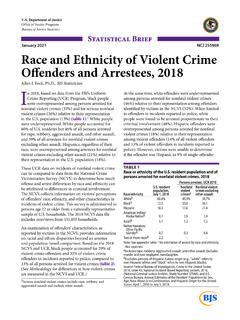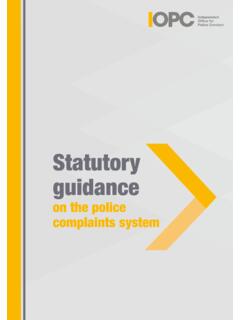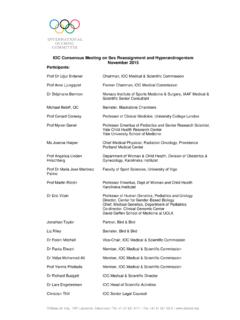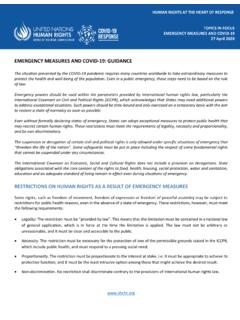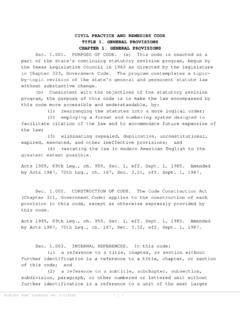Transcription of Multi-academy trusts: benefits, challenges and functions ...
1 Published: July 2019 Reference no: 190032 Multi-academy trusts: benefits, challenges and functions An investigation into Multi-academy trusts: how their central vision and approaches influence day-to-day practice in schools, and to what extent they are having a positive or otherwise impact on the work of leaders and teachers in the schools we inspect. Multi-academy trusts: benefits, challenges and functions July 2019, No. 190032 2 Contents Introduction 3 Background to this project 5 Methodology 6 Sampling 7 Who we talked with 9 Tools used 9 Analysis 10 Results 10 There is both commonality and variance in the functions of MATs in the system 10 Schools see a range of benefits to being part of a 14 ..but they also identified drawbacks 18 MATs use a range of mechanisms to hold their schools to 22 ..but there is often limited accountability of the MAT itself 23 Governors are not always clear on the role of the local governing body 25 Recommendations 26 Recommendations for Ofsted and the DfE 26 Recommendations for MATs 26 Multi-academy trusts: benefits, challenges and functions July 2019, No.
2 190032 3 Introduction 1. Since 2002, the academy programme has been a central part of the education system and of successive governments plans for raising educational standards. A focus on the challenge of failing or under-subscribed schools and under-performance meant that new academies, linked to a government-approved sponsor, replaced these schools,1 taking them out of local authority (LA) control. The National Audit Office reports that there were over 1,100 approved sponsors in January 2. The Academies Act 20103 made academy status open to all schools, subject to Department for Education (DfE) approval. S ince that time, the number of academies has rapidly increased. Furthermore, while initially most academies were standalone, a growing number have become part of Multi-academy trusts (MATs). Though most MATs are small, they vary greatly in size (from as few as two to well over 50 schools). 3. A MAT is often described as a collaborative of schools.
3 However, this understates the legal status of a MAT, which is quite different from that of other forms of school collaboratives, such as federations. In a MAT, it is the trust itself that is the legal entity, and not the schools that are its constituents. This means that the MAT has responsibility for the governance of its schools, although MATs may delegate specific powers to local governing bodies (LGBs). The MAT is accountable for the performance of each school in the group. A master funding agreement with the MAT and supplemental funding agreements with each individual academy are signed by the Secretary of State for Education. 4. Not all academies belong to MATs. Many academies are standalone academies. However, standalone academies may struggle with capacity to manage change and to develop the school. Therefore, the DfE has encouraged schools to become part of MATs, which are seen as having clear benefits in terms of both improving standards and increasing financial efficiencies and If Ofsted has judged a maintained school s overall effectiveness as inadequate, the school receives a directive academy order and must become a sponsored academy.
4 Ninety-eight per cent of schools that are given a directive academy order join a MAT. 1 MS Gibbons, and O Silva, What s in a name? Expectations, Heuristics and Choice During a Period of Radical School Reform , in CEP , 1477, 2017. 2 Annual Report and Accounts , NAO, 2018-19; . 3 Annual Report and Accounts , NAO, 2018-19; . 4 Multi-academy trusts: good practice guidance and expectations for growth , DfE, 2016; Multi-academy trusts: benefits, challenges and functions July 2019, No. 190032 4 5. About 35% of all state-funded maintained schools are now This figure masks considerable differences between LAs and across phases. For example, the proportion of secondary schools that are now academies was 72% in 2018, much higher than for primary schools (27%) and special schools (34%). In individual Las, the proportion of schools that are academies ranges from 93% in Bromley to 6% in Lancashire, Lewisham and North In 2017, almost three quarters of academies were part of a 6.
5 When they convert to an academy, schools take on several duties and responsibilities as well as a number of freedoms compared with maintained schools. Academies meet these responsibilities either by converting to a single standalone convertor academy, by forming a new MAT or by joining an existing MAT. Governance and accountability of the academy become the responsibility of the trust and its trustees. These accountabilities are financial as well as educational. For example, academies are allowed more freedom to set staff pay and conditions and to determine their own curriculum than LA-maintained schools. Nonetheless, the curriculum must be broad and balanced, and the academy s provision must meet all a school s statutory duties, such as keeping children safe and complying with the Equality Act 2010. 7. Ofsted has a duty to inspect academies under section 5 of the Education Act We do not inspect MATs, although we do carry out MAT summary evaluations of the quality of education provided by a MAT and leaders contribution to this.
6 In doing so, we draw on previous inspections of individual academies within a MAT as well as meetings and discussions with MAT leaders about these batched inspections . These summary MAT evaluations are carried out in line with the letter from the Secretary of State for Education to Her Majesty s Chief Inspector on 13 December W e have also recently published guidance f or both inspectors and MATs about The summary evaluations are not inspections but aim to make helpful recommendations as to how MATs might improve further. 8. In our MAT summary evaluations, Ofsted aims to consider all important information about the MAT; from academy inspections, discussions with MAT leaders and on-site visits to MAT academies. We then use this to provide the MAT with helpful recommendations on aspects that could be improved, and to 5 Annual Report and Accounts , NAO, 2018-1 9.
7 6 Annual Report and Accounts , NAO, 2018-19; . 7 A West and D Wolfe, Academies, the School System in England and a Vision for the Future , in ERG LSE , 23, 2018; England-and-a-Vision-for -the-Future. 8 Education Act , UK Legislation, 2005; Section 5; 9 Education Act , UK Legislation, 2005; Section 5; 10 Multi-academy trusts: summary evaluations , Ofsted, 2018; Multi-academy trusts: benefits, challenges and functions July 2019, No. 190032 5 recognise when MAT leaders are having a positive impact on the quality of education in the individual academies. MAT summary evaluations are carried out across two stages. In Stage 1 (batched inspections) Ofsted collects evidence about the individual academies within the MAT through the section 5 and section 8 inspections that are already due, usually in a single term. These inspections follow the procedures set out within the relevant handbooks. After Stage 1 we publish all section 5 and section 8 inspection reports before Stage 2 commences.
8 In Stage 2 (the summary evaluation), which may be in the same term or the term after we complete the batched inspections, inspectors will meet the leaders of the MAT and discuss the findings of the individual inspections and overall educational quality across the MAT, over the course of a week. Inspectors will also meet trustees. There will be an opportunity for inspectors to visit individual academies or sites with the MAT s agreement. These visits are not inspections, and it is important to note that summary evaluations are also not inspections. Ofsted does not have the power to insist that MATs engage with summary evaluations. Background to this project 9. This research project reflects Ofsted s determination for its inspection and evaluation work to be evidence-based and research-informed. We began the project in the summer term of 2018. Feedback from both MATs and their schools and indeed from our inspectors indicated that not everyone understood how diverse the sector had become in terms of governance and organisational structures.
9 We want our inspectors to be up to date and informed about MATs so that we fulfil our responsibilities and duties in relation to both MAT summary evaluation and school inspection even more effectively. 10. The growth of MATs has led to a range of academic research on their impact, and, to a lesser extent, their functioning (see for example Francis et al, 2016;11 Andrews, 2016;12 Finch et al, 2016;13 Greany and Higham, 2018;14 Andrew and Perera; 201715 and Greany 201816). 11 B Francis and M Hutchings, Chain effects 2017 , The Sutton Trust, 2017; 12 J Andrews, School performance in Multi-academy trusts and local authorities 2015 , Education Policy Institute, 2016; 13 A Finch, B Dobson, E Fischer and A Riggs, Academy chains unlocked , Reform, 2010; 14 T Greany and R Higham, Hierarchy, markets and networks: analysing the self-improving school-led system agenda in England and the implications for schools , UCL Institute of Education, 2018; 15 J Andrew and N Perera, The Impact of academies on educational outcomes , Education Policy Institute, 2017; 16 T Greany, Sustainable improvement in multi-school groups , UCL Institute of Education, 2018; school-groups.
10 Multi-academy trusts: benefits, challenges and functions July 2019, No. 190032 6 11. However, although there is burgeoning body of knowledge about central vision and approaches within MATs, we know less about how these influence day-to-day practice in schools, and to what extent MATs are having a positive or otherwise impact on the work of leaders and teachers in the schools we inspect. 12. This research project therefore set out to answer three questions: What are the main functions of a MAT? What does it mean for a school to be part of a MAT? What are the implications for inspector training and inspection practice and guidance? 13. The study was not designed to evaluate the work of individual MATs. We wanted to hear the views of those who work within a MAT about what it meant to them to be part of one. In particular, we asked them about the benefits and challenges of being part of a MAT, things they wished the MAT did more of, or less of, and what were the most important things a MAT should do.











